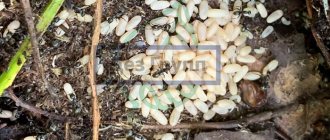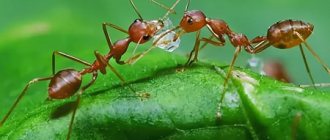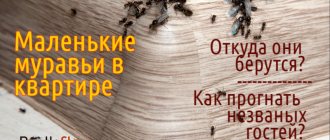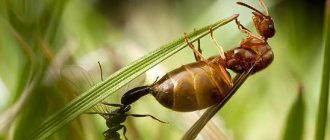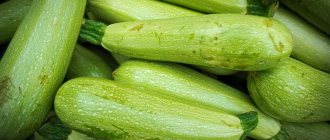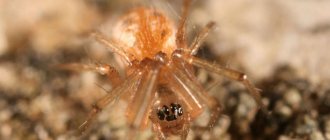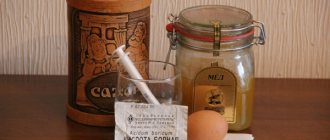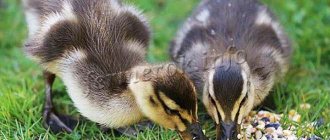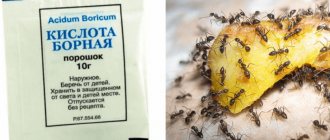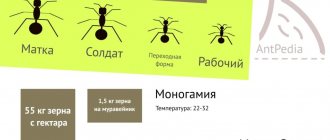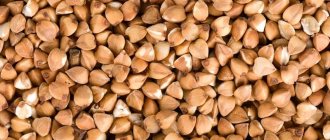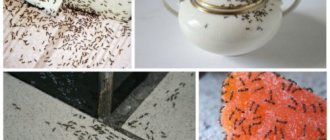What do ants need for normal life in a formicarium? Preparing a complete and varied diet for ants. Examples of foods containing proteins and carbohydrates. How much food is needed for arthropods? Useful microelements. Growing food insects.
The key to a thriving colony is the availability of a nutritious and varied diet. Speaking of natural conditions, ants feed on different types of insects - flying, crawling, living and not, a variety of plants, and aphids share the sugar they extract with arthropods.
Providing adequate nutrition for a home colony is not an easy task; let’s look at what to feed the ants in an ant farm. Conventionally, the diet of such insects is divided into carbohydrate and protein food. Equally important is compliance with the intake of salt and microelements.
Protein food
All ants are predators by nature. Even if we are talking about a non-aggressive species of ants. They happily drag a found caterpillar or beetle into their anthill. This means that you must feed the ants living in the ant farm with protein. Dried gammarus, lean meat, shrimp, boiled egg, fish, nuts. It is better to scald raw foods, such as meat, with boiling water before serving.
The favorite foods of ants are zoophobes, medicine man, crickets, mealworms and other feeding insects. Remember that these treats must be purchased at a pet store or grown yourself. By bringing beetles from the street, you risk infecting the colony with parasites.
Important! If the ant family is still small, then live food should be given with caution. It must be killed before being placed in the feeder. Otherwise, the insect may harm the colony or even lead to its death.
The development of the colony directly depends on the amount of protein eaten. Protein is especially useful for the queen. Don't forget to regularly pamper the colony with meat and live food. In gratitude, you will receive a huge clutch of eggs from which large soldiers and workers will be born. But if the queen understands that she has nowhere to get the squirrel, then she will eat the brood.
Portion or quantity of feed
Many novice myrmikeepers have a fair question - how often to feed the ants? Lunch time, as well as portion size, matters. Loving owners often show unnecessary care and overfeed their colony. This can be even more harmful than short hunger strikes.
Careful observation will help you determine how much to eat. If pets leave an uneaten piece of boiled meat or half a cricket, it means they are full. The remains should be removed from the formicarium, and next time a smaller portion should be offered.
If you notice that newborn babies are small in size, this indicates a lack of food. Add protein dishes to your diet. It is the protein that helps the brood mature and grow into normal-sized individuals.
Over time, each aspiring myrmikeeper gets to know his colony better. There is an understanding of portion size and culinary preferences. Watch your pets, notice changes in mood and activity. Feed a variety of healthy foods. Do it carefully and with pleasure.
Hard food
The Reaper Ant (Messor Structor) is a granivorous ant - gatherer. Speaking about grain feed, we will talk about this type. A mixture of seeds and various grains is a source of energy for little hard workers. Ants living at home should have constant access to carbohydrates. You can place a feeder filled with seeds in the arena. They will definitely carry some of the grains into the living passages of the formicarium. Having chosen the driest chamber, they will arrange a storage room there. This will be an emergency reserve. They will take care of it, sort it out and dry it.
The grains left in the arena will be the main food. Soldier ants with large mandibles grind seeds into flour for the whole family.
Poppy seeds, rapeseed, millet, sesame, flax, millet, alfalfa, chia are best suited. Wheat, oats, pumpkin seeds, etc. will be too large for them.
How often to feed ants
There are 2 main problems when feeding ants. Overfeed and underfeed. If you don't feed them enough, they will starve. Then, when food arrives, they will spend it more economically. They will make supplies in case of a hunger strike.
If the ants do not receive enough food, the size of the young individuals will decrease. Less food, less protein, less energy. In this case, it is more profitable to be a small organism.
If there is too much food, the ants may not eat it, which means the risk of mold and mites increases. These are harmful neighbors for ants. If the food collects dust and the ants do not touch it, then it is too large a portion. Most likely it will lie in a cell where you cannot reach it.
We come to the conclusion that it is better to give food in small portions, which the ants quickly absorb. Then we reduce the risk of mold to zero. And the ants will delight you with their large size.
The reapers put the seeds in the chamber
Syrups and sweet fruits
Ants have a real sweet tooth. In nature, they feast on flower nectar, carbohydrate-containing plant sap, and aphids. The latter is like a cow to them. Only what they get from it is not milk, but a sweet solution (honeydew).
In a formicarium, the ant economy, of course, will not be able to develop like this. Therefore, it is the owners’ task to deliver treats. You can use sugar or honey syrups, or glucose purchased at the pharmacy.
Important! It is strictly forbidden to give sweets to the Reapers. Sweet fruits and syrups lead to dehydration and death. In just a few hours, the entire colony can die.
Remember that syrups are a perishable product. Do not allow it to sour inside the farm.
Carbohydrates
Carbohydrates are the main source of energy for imago (adult individuals). In other words, carbohydrate is represented by sugar or sweet treats. This need forces the arthropods to observe and catch the aphids, then they begin to protect them, and the aphids thank them by secreting droplets of sweet juice.
Many plants are also distinguished by sweet secretions - such areas are jealously protected from pests. Insects often extract nectar from flowers.
Because of this, the main (but not the only) nutritional element for a colony of red, black, garden ants, and reapers in a formicarium is sugar syrup. But many people wonder whether it is possible to give pure sugar or honey? Not recommended, since the concentration of sweetness in juice, nectar and secretions is no more than 10 percent.
It is best to dilute the treat in water in a ratio of 1 to 2, ideally 1 to 3, and then give the ants the prepared syrup. To eliminate the risk of insects drowning in liquid (which is especially important for small varieties), it needs to be soaked with a piece of cotton wool.
The syrup is characterized by the presence of one big drawback - rapid spoilage (the onset of fermentation), which turns it into real poison. Such food should be supplied exactly in the amount that individuals can drink in one day.
What else can you feed the ants? A good option is marmalade, but here it is important to ensure that the composition is natural; it should contain a minimum amount of dyes and preservatives. This is a fairly convenient method, since it does not ferment, it is easier to dose, and there is no risk of dirtying the farm.
The optimal solution is to replace sweets (the pure kind) with fruits as much as possible when feeding ants. The same apples contain a sufficient amount of fructose, and this is much healthier for the body.
Yes, arthropods need sweets, but do not forget that under natural conditions it is quite difficult for insects to obtain carbohydrates. If they get their hands on sweet treats, their first instinct is to eat everything. The arthropods fill their bellies so much that they become translucent.
This feature leads to a decrease in the activity of the colony. Arthropods, drunk on syrup, sit in secluded places so as not to waste their energy in vain - such individuals turn into a living “refrigerator”, storing valuable food for their relatives.
Such an individual will work poorly and will not care for the brood, which only harms, since there is a risk of feeding its relatives to the point where they will not care about their main responsibilities, including raising a new generation.
Therefore, there is no need to spoil ants with sweets. An excellent option is regular consumption of treats, but in small portions of honey, sugar, fructose, glucose, marmalade, souffle, nougat. With great pleasure, ants eat apples, peaches, apricots, grapes, pineapple, and mangoes.
How ants feed the queen
Firstly, the uterus is large and independent, so it can take care of itself. After all, she somehow survives alone. It does not always live off fat deposits and the decomposition of its own muscles.
Ants try to give the queen protein and carbohydrates. Mainly protein. So the queen lays more eggs.
An ant has 2 stomachs. One for yourself. The second stomach is used to store food. This is called tropholaxis. One goose bump leads to another. He knocks with his antennae and receives food in return.
Womb of the Reapers
The same scheme works with the uterus.
Good day.
In this topic, I propose to share information about who feeds their ants when and what. What they recognize as breakfast quality and what they fundamentally ignore. It may be possible to identify preferences for one type or another.
Here's what we found out...
The information was drawn from this forum topic, as well as from the experience of the “great experimenter” antfarmer (entry in his diary “I acquired laboratory fruit flies”). A little about the structure of information. First comes a list of things you can try to diversify the ants’ diet without much risk of harming their health. The comments in quotes are the results of antfarmer's experiments: in Section “1. Plant food"
(entry in his diary “I acquired laboratory fruit flies”). A little about the structure of information. First comes a list of things you can try to diversify the ants’ diet without much risk of harming their health. The comments in quotes are the results of antfarmer's experiments: in Section “1. Plant food"
he experimented with messors, the rest of the comments relate to lasius and formica (the corresponding section of the post will be updated a little later). Some of the comments appeared later, as the activity of the Club members increased. Then, I tried to outline the main species preferences.
"Ant menu".
1. Plant foods:
- 1.1. bread (bread crumbs) “not very”; 1.2. Finn Crisp croutons “this way”; 1.3. “puffed up” wheat with honey was “actively devoured”; 1.4. freeze-dried noodles soaked in milk (wheat) - “actively devoured”; 1.5. freeze-dried noodles soaked in milk (corn) “tried”; 1.6. freeze-dried noodles soaked in milk (rice) – “tried”; 1.7. freeze-dried noodles not soaked (all) – “ignored”; 1.8. soy meat, tofu – “eat”; 1.9. seaweed - “ignored”; 1.10. candied fruits – “very sluggish”; 1.11. seeds: 1.11.1. oatmeal (flakes), rolled oats; 1.11.2. millet, rice, buckwheat – “ignored”; 1.11.3. sunflower seeds, etc.
2. Sweet:
- 2.1. “Wild” people eat honey, but home-grown ones don’t touch honey.” CAUTION: after some time, honey will ferment and from a delicacy will turn into “death” for ants; 2.2. sweet (sugar) syrup (sugar in water 1:1). CAUTION: Do not take trot cream or ice cream; 2.3. chocolate - “avoid”; 2.4. marshmallows - “they eat very actively”; 2.5. marmalade (do not take poisonous flowers) is “actively eaten.”
3. Insects, including insect food crops.
All types of ants eat them.
- 3.1. house flies and other flies; 3.2. fruit flies (including wingless laboratory ones) – “actively devoured”; 3.3. wax moth (imago); 3.4. mosquitoes; 3.5. cockroaches of different colors (for example, marbled cockroach). CAUTION: Do not use “our” pet cockroaches; 3.6. bloodworm / “Initially there is interest.
But only in Camponotus. Then - to the trash" / ; 3.7. beetles, bee larvae, maggots, small crickets (for example, banana cricket) and other running, crawling and flying insects...
4. Boiled eggs (chicken):
- 4.1. the yolk was “actively devoured”; 4.2. “just tried” the protein.
5. Bird:
- 5.1. chicken meat, raw or cooked.
6. Meat:
- 6.1. beef; 6.2. liver (raw or cooked); 6.3. boiled beef heart “they eat very lightly, but they try to hide it.”
7. Fish:
- 7.1. raw and boiled fish, squid “were not even ignored, but avoided.”
8. “Complex” products:
- 8.1. milk sausage - “they devour BUT THERE WERE VICTIMS” experiment less.
9. Dairy products:
- 9.1. sour cream “for some reason they attacked her, ... ran like they had been stung and bit everything”; 9.2. yogurt, cottage cheese (low-fat) - “actively eaten.”
10. Gelatin feed:
- 10.1. With an admixture of sugar, honey, vitamins, egg yolk (there are also diets with a more complex composition). This mixture is frozen and stored in the refrigerator.
11. Fruits:
- 11.1. Sweet apples. 11.2. Sweet soft pear. 11.3. Pineapple (not canned). 11.4. Grape. 11.5. Bananas. 11.6. Most likely, other fruits need to be checked.
Now information about which ants prefer what:
1. Formica rufibarbis:
Points: 3 (everyone eats ), 5, 6.1.
), 5, 6.1.
(weak) and 7. 2. Tetramorium ceaspitum:
“There is no more omnivorous ant.”
3. Camponotus ligniperda:
Points: 3.1, 3.3., 3.4., bee larvae and marbled cockroaches do not go (possibly due to the smell).
4. Messor constructor:
Points: 1.1.
— 1.6., 3.2., 4. (comments accordingly), 1.11.2. — the “wild” ones didn’t ignore them, the domestic ones apparently weren’t that hungry. 5. Lasius niger (from my own experience):
Points: 1.3.
(gnawed honey); 2.1. (they attacked very actively); 2.5. (not so active); 3.2., 3.6. (were active); 4.1. (weak); 5.1. (weak), 11.2. (with pleasure), 11.3. (ignored), 11.4. (tried it... seemed to like it), 11.5. (somehow, no way). ‹ Salt to messora ants ›
How to keep harvester ants at home
Nowadays, many people, as a hobby, start so-called ant farms, which are transparent boxes made of plastic or glass. Inside them there is an imitation of an anthill - numerous passages and chambers.
Purchasing an anthill - what kinds of anthills there are, their cost
A home anthill, or formicarium, looks like an aquarium or a display case with filler inside. There are simple and complex systems in which a climate favorable for the life and reproduction of ants is automatically created and maintained: lighting, humidity and temperature. There are different sizes - from small tabletop farms to bulky anthills for the living room or office. Various fillers are used for formicaria: gel, gypsum or a mixture of soil and sand.
The so-called “Cubus” and “Colosseum” models are shaped like a cylinder, cube or double-walled display. The space between them is filled with multi-colored sand, in which the ant colony builds passages and chambers. The cost of such structures is high - from 3 thousand rubles, but the kits include food for ants, sand and other additions.
An anthill with a gel filler is similar to an aquarium, but is filled not with water, but with a transparent gel. Such a house for reapers does not require careful maintenance, but once every 5–7 days the lid of the aquarium must be opened for a couple of minutes for ventilation. The price of such formicariums is low - from 500 rubles.
A plaster truss is affordable in price (from 700 rubles). This is the most popular type of domestic anthill. The surface of the gypsum is often painted in bright colors, which makes formicariums a stylish and unusual addition to any interior.
Ant houses can be purchased in specialized online stores. The catalogs contain farms of various models and sizes. As a rule, pet stores do not sell ant farms.
Making a formicarium yourself
If you are not attracted by prices in stores, then there is the opportunity to make a formicarium with your own hands. For the base, you can take two jars with transparent walls - a large and a small one - and then fill the space between them with the selected material. It can be a mixture of soil and sand, gypsum or gel.
Soil-sand farm
To begin, prepare a mixture of one part sand and two parts soil. Make sure that the composition is slightly damp - it will be easier for ants to break through passages and chambers. The mixture will be needed so much that the space between the jars is filled 1.5 cm from the edge of the vessels. Make small holes in the lid for air circulation.
Gel farm
Making such a farm yourself will be interesting for both adults and children. To do this, you will need gelatin and a flat container with a lid and transparent walls.
Pour three 15 gram bags of gelatin into 0.5 liters of hot water and stir well until the gelatin dissolves. Then add another 0.5 liters of water. Cool the resulting composition, pour into a container of your choice and place in the refrigerator until completely solidified. Then remove the container and wait for the mass to warm to room temperature. Since the gel composition is also food, there is no need to feed the ants in such an anthill - they will get the necessary food from their house.
Gypsum farm
To create an anthill, take a transparent container, then dilute the plaster to a thick sour cream. Pour the composition into a transparent plastic container, placing a plastic straw at the side. This is necessary in order to then add water to the plaster to maintain humidity in the formicarium.
The workpiece dries completely in about a week. After three to four days after pouring, remove it from the mold. To make the plaster come out easily, immerse it in hot (not boiling water) water for thirty seconds.
Now show your creativity - draw passages and rooms on the plaster. The composition is still raw, so it will not be difficult for you to scratch out any tunnels.
Drill an entrance for future residents of the farm using a drill. Take any tool convenient for you (a stationery knife, screwdriver, etc.) and start making paths according to your design, choosing plaster from them. Proceed with caution so that the wet mixture does not crumble.
Make indentations at the bottom of the formicarium to better distribute water and moisturize the anthill. Don't forget about the ventilation holes in the container. Drill them with a drill (0.5 mm diameter) in the lid and side walls.
After this, you need to thoroughly dry the gypsum base and place it back into the container. If it does not fit, soak the mold in hot water again for 30 seconds. Your anthill is ready to move in.
To bet or not to bet
There are actually situations in which reapers will need liquid, but they all involve lowering the humidity on the farm. If for some reason the humidity drops below 70%, and there is no way to influence this, installing a container with water will be the only possible solution.
A drinking bowl will also be needed in cases where the farm owner leaves for longer than 4-5 days and there is no one to water the farm.
You can make a drinking bowl yourself or purchase a ready-made version, tailored to the size and conditions of your formicarium:
Moistened piece of cotton wool
- the simplest option, requiring frequent replacement.
Any hollow tube, test tube, cap
, into which water is poured and then tucked with a cotton swab - lasts much longer.
The finished drinker has an internal dosed feeding system; it is good because it does not require unnecessary movements from the keeper: fill it up, set it up and forget it. Which option you choose doesn’t really matter. After all, they will all solve the task, namely, provide the ants with water. However, it is worth taking care to return the reapers to their natural level of humidity as soon as possible, because they are accustomed to absorbing water from the air; a separate supply of water for them is rather a temporary, necessary measure.
See what's included in each kit:
Source
Daily bread
Depending on the type of ants, food is selected. For example, reapers prefer plant foods, while red forests feed on insects. However, for all varieties of these insects there are general feeding rules:
- Remove leftover food promptly.
- Do not overfeed insects.
- Monitor the freshness of the water.
- Monitor its presence in the sippy cup.
- Expand your diet with pieces of fruit or syrup.
It is better to give food once or twice a week, in small portions, and make sure that insects do not take it throughout the colony. It is important to find a balance with the amount of food and water, otherwise the food may begin to spoil and poison the lives of the babies.
Basic rules for maintaining an ant farm
Beginners will be interested in other rules for caring for ants that will help in their maintenance:
- Beginner myrmikeepers (as those who breed ants are called) are recommended to purchase insects of the messor structor family. They are undemanding to living conditions and have a clear classification by profession. At the same time, they differ in size and properties, so everyone can find an option “to their liking”;
- the worker ant lives about 3 years, the queen lives up to 25 years or more.
To organize an ant farm, first a small formicarium with dimensions of 25x20x10 cm (“M”) is suitable. After about 2-3 years, the colony grows and if the owner of the farm wants to increase the population, he will need a more serious house for ants, which can be bought on our website. If there is no such desire, the ants themselves will control the optimal number. Delivery to any region of the country is possible, since the insects are sent in special containers with the necessary supplies of water and food.
What do harvester ants eat?
Particular attention should be paid to the feeding and extraction of food by the reapers. Since they most often feed on grain crops, ants were long thought to be agricultural pests. However, research has shown that insects only harvest crops that directly fall to the ground.
Reserves
The gathering of provisions is very interesting among the reapers. As stated earlier, the harvesting of grain occurs when it is on the ground.
Scientists have found that harvester ants send out workers as much as there is available food. If there is a lot of it, then the workers return faster and the number of ants sent for food increases. But if they return slowly, then the number of ants sent out decreases or stops altogether.
To store grain, hardworking reapers set up special rooms deep underground. In damp, warm rooms, the seeds begin to germinate, and as soon as the first sprouts and roots appear, the ants immediately destroy the shoots. After this, large soldier ants grind the grain into powder with their powerful jaws and, moistening it with saliva, feed this mixture to the larvae.
Appearance of harvester ants and their habitat
The genus of reapers consists of 110 species. The steppe harvester ant stands out among its relatives for its size. The large queen grows up to 1.5 cm, and the size of working insects is from 4 to 9 mm. The dark brown body with a reddish tint consists of a head, chest and abdomen, connected by bridges. Powerful mandibles resemble a trap and are capable of crushing grain.
It will not be possible to see the reaper anthill in the usual sense for many people. They make their nest underground. The entrance to it is surrounded by a shaft of soil mixed with debris from grains and seeds. The older the anthill, the higher this barrier. A developed colony may have several exits to the surface. A tunnel leads down from the hole with branches for chambers for different purposes: storerooms, mangers, the queen’s refuge. There is only one queen in each family. Young fertilized uteruses never remain in it.
Appearance
In harvester ants, sexual polymorphism is pronounced. By appearance, you can distinguish between a queen and a male, a worker and a soldier. There are also transitional forms. The smallest insects take care of their offspring. The task of large individuals is to guard the nest and grind plant seeds.
